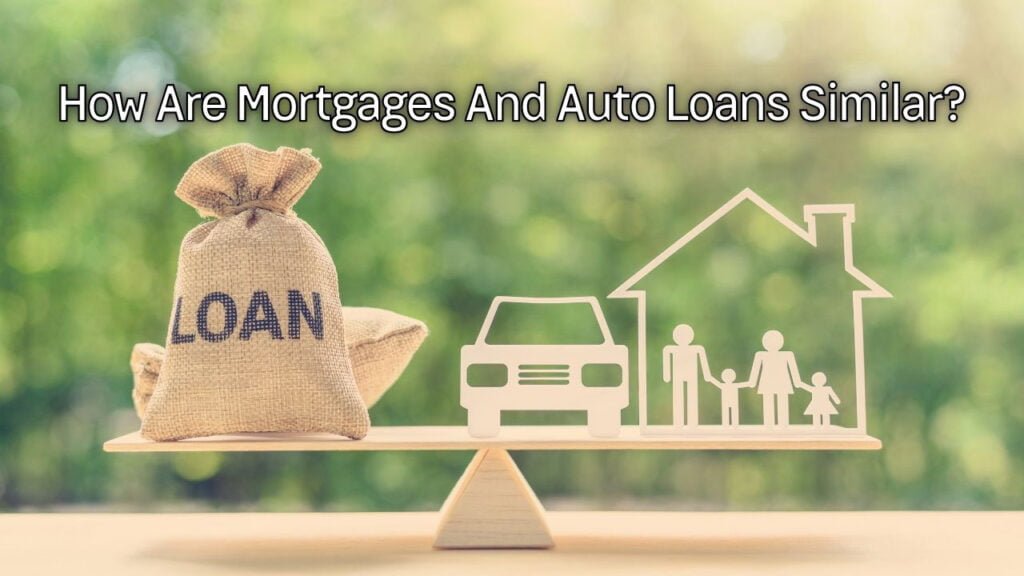How are Mortgage and Auto loans Similar?
How are Mortgage and Auto loans Similar? Many people want to know this. When it comes to financing large purchases, such as a home or a car, most people turn to loans to make their dreams a reality. Two common types of loans that individuals often seek are mortgage loans and auto loans. While the purpose of these loans is different—one for purchasing a home and the other for buying a vehicle—there are several similarities between mortgage and auto loans. In this article, we will explore these similarities and highlight the key aspects that borrowers should consider when obtaining these loans.
1. Secured Loans:
Both Mortgage and Auto loans are examples of secured loans. A secured loan is a type of loan that is backed by collateral. In the case of a mortgage loan, the collateral is the property being purchased. The property serves as security for the lender, allowing them to repossess and sell it in the event of loan default. Similarly, with an auto loan and car loans, the vehicle being financed serves as collateral. If the borrower defaults on the loan, the lender has the right to repossess the vehicle to recover the funds.
2. Fixed or Variable Interest Rates:
Another similarity between Mortgage and Auto loans is that they can have either fixed or variable interest rates. A fixed interest rate remains the same throughout the loan term, providing borrowers with a predictable repayment plan. This type of rate is commonly associated with home mortgage loans, allowing homeowners to budget their monthly expenses effectively. On the other hand, auto loans can have either fixed or variable interest rates. Variable rates are subject to change based on market conditions, which means that borrowers may experience fluctuations in their monthly payments.
3. Loan Term Length:
Both Mortgage and Auto loans come with specific loan term lengths. A loan term refers to the duration over which the borrower agrees to repay the loan. Mortgages And Auto Loans typically have longer terms, commonly ranging from 15 to 30 years. The extended term allows homeowners to spread their repayments over an extended period, making homeownership more affordable. In contrast, auto loans usually have shorter loan terms, typically ranging from 3 to 7 years. The shorter term reflects the shorter lifespan of vehicles and allows borrowers to own their cars free and clear relatively quickly.
4. Down Payments:
Another shared characteristic Mortgage and Auto loans is the requirement for down payments. A down payment is a lump sum payment made by the borrower at the time of purchase to reduce the loan amount. Mortgage lenders often require a down payment of at least 20% of the home’s purchase price, although there are options available with lower down payment requirements. Auto loans also require down payments, typically ranging from 10% to 20% of the vehicle’s purchase price. Providing a down payment helps borrowers establish equity in the property or vehicle and reduces the risk for the lender.
5. Credit Evaluation:
Both Mortgage and Auto loans involve a thorough evaluation of the borrower’s creditworthiness. Lenders assess factors such as credit history, credit score, income stability, and debt-to-income ratio to determine the borrower’s ability to repay the loan. A higher credit score and a strong credit history increase the chances of securing favorable loan terms, including lower interest rates. Additionally, lenders may consider the borrower’s employment history and income level to ensure that the monthly loan payments are affordable.
6. Pre-Approval Process:
Prior to obtaining a mortgage or auto loans, borrowers have the option to go through a pre-approval process. Pre-approval involves submitting financial information and documentation to a lender who then assesses the borrower’s eligibility for a loan. The pre-approval process provides borrowers with an estimate of how much they can borrow, which helps in determining a suitable price range for a home or a vehicle. It also demonstrates to sellers or dealerships that the borrower is a serious and qualified buyer.
In conclusion, although Mortgage and Auto loans serve different purposes, they share several similarities. Both types of loans are secured, meaning they require collateral, and they can have either fixed or variable interest rates. The loan term lengths and the need for down payments also align between the two loan types. Additionally, credit evaluations and the option of pre-approval are essential steps in both mortgage and auto loan processes. Understanding these similarities can help borrowers navigate the loan application process more effectively and make informed decisions when financing their homes or vehicles.
7. Importance of Loan Amount and Loan-to-Value Ratio:
Both mortgage and auto loans take into account the loan amount and the loan-to-value (LTV) ratio. The loan amount refers to the total funds borrowed, while the LTV ratio is the percentage of the loan amount in relation to the appraised value of the property or the purchase price of the vehicle. Lenders consider these factors to determine the risk associated with the loan. In mortgage loans, a lower LTV ratio (typically 80% or less) often leads to more favorable loan terms, such as lower interest rates and waived private mortgage insurance (PMI). Similarly, in auto loans, a lower LTV ratio may result in better interest rates and more flexible repayment options.
8. Amortization:
Both Mortgages And Auto Loans follow an amortization schedule. Amortization refers to the systematic repayment of the loan over time through fixed monthly payments. These payments are structured to cover both the principal amount borrowed and the accrued interest. Initially, a larger portion of each payment goes toward interest, while the remainder reduces the principal balance. As the loan progresses, the ratio shifts and a higher percentage of the payment goes toward reducing the principal. This gradual repayment method allows borrowers to build equity in their homes or vehicles over time.
9. Default and Foreclosure/Repossession:
In both Mortgages And Auto Loans, defaulting on payments can have serious consequences. If a borrower consistently fails to make mortgage payments, the lender may initiate foreclosure proceedings, leading to the forced sale of the property to recover the outstanding debt. Similarly, in auto loans, failure to make timely payments can result in repossession, where the lender reclaims the vehicle. Both foreclosure and repossession can have long-term negative impacts on the borrower’s credit score and financial well-being.
10. Refinancing Options:
Both mortgage and auto loans offer the possibility of refinancing. Refinancing involves obtaining a new loan to replace the existing one, often with improved terms. Mortgage refinancing allows homeowners to take advantage of lower interest rates, reduce monthly payments, or change the loan term. Auto loan refinancing serves a similar purpose, enabling borrowers to secure better interest rates or extend the loan term to lower monthly payments. Refinancing can be a viable option for borrowers seeking to improve their financial situation or take advantage of favorable market conditions.
11. Impact on Credit Score:
Both mortgage and auto loans have a significant impact on a borrower’s credit score. Timely payments and responsible loan management can positively influence the credit score, demonstrating financial stability and reliability. Conversely, missed payments or defaults can have a detrimental effect, lowering the credit score and making it more challenging to secure future loans or obtain favorable interest rates. Borrowers should be mindful of their loan obligations and ensure prompt payment to maintain a healthy credit profile.
12. Tax Deductibility:
One notable similarity between mortgage and auto loans is the potential for tax deductibility, although the specifics differ. The mortgage interest paid on a primary residence may be tax-deductible, subject to certain limitations and regulations. This deduction can provide homeowners with a financial benefit. On the other hand, auto loan interest is generally not tax-deductible for personal-use vehicles. However, in some cases, if the vehicle is used for business purposes, such as for self-employment or as part of a company’s fleet, a portion of the interest may be eligible for deduction. It is advisable to consult a tax professional for accurate information regarding tax deductions.
Understanding the similarities between mortgage and auto loans can empower borrowers to make informed decisions when it comes to financing major purchases. By recognizing the shared characteristics, such as secured nature, interest rates, loan terms, down payments, credit evaluations, and pre-approval processes, borrowers can navigate the loan application process with confidence. Additionally, considering factors like loan amount, amortization, default consequences, refinancing options, credit score impact, and potential tax deductibility helps borrowers manage their loans effectively and optimize their financial well-being.
Read about SEO Strategy
Related
Related posts
Categories
- Accident Lawyers (19)
- Adventure (1)
- Art (7)
- Author (24)
- Books (34)
- Business (32)
- Celebrity News (8)
- Debt (6)
- Design (3)
- Economy (11)
- Educational info (74)
- Events (11)
- Fashion (7)
- Filmmakers (8)
- Food (29)
- Gaming (10)
- Guide (7)
- Health & Beauty (43)
- Home (41)
- Insurance (8)
- Interior (1)
- Life (1)
- Lifestyle (5)
- Loans (11)
- Mortgage Loans (5)
- Motivation (4)
- Music (10)
- Parenting (1)
- People (3)
- Pets (5)
- Photography (4)
- Podcasts (5)
- Politics (2)
- Products (23)
- Relationships (3)
- Review (1)
- Scholarship (15)
- Student Loan (3)
- Style (1)
- Tax Lawyer (3)
- Tech (58)
- Travel (30)
- TV And Film (2)
- Uncategorised (8)
- Uncategorized (9)
Subscribe Now
* You will receive the latest news and updates on your favorite celebrities!




Social Media